Selina ICSE Concise Physics for Class 10 Physics
Chapter 8 Current Electricity
Exercise 8(A)
1.Define the term current and state its S.I. unit.
Solution 1.
Current is defined as the rate of flow of charge.
I=Q/t
Its S.I. unit is Ampere.
2.Define the term electric potential. State it's S.I. unit.
Solution 2.
Electric potential at a point is defined as the amount of work done in bringing a unit positive charge from infinity to that point. Its unit is the volt.
3.How is the electric potential difference between the two points defined? State its S.I. unit.
Solution 3.
The potential difference between two points is equal to the work done in moving a unit positive charge from one point to the other.
It’s S.I. unit is Volt.
4.Explain the statement 'the potential difference between two points is 1 volt'.
Solution 4.
One volt is the potential difference between two points in an electric circuit when 1 joule of work is done to move charge of 1 coulomb from one point to other.
5.
Solution 5.
In a metal, the charges responsible for the flow of current are the free electrons. The direction of flow of current is conventionally taken opposite to the direction of motion of electrons.
6.State Ohm's law and draw a neat labelled circuit diagram containing a battery, a key, a voltmeter, an ammeter, a rheostat and an unknown resistance to verify it.
Solution 6.
It states that electric current flowing through a metallic wire is directly proportional to the potential difference V across its ends provided its temperature remains the same. This is called Ohm’s law.
7.Draw an I - V graph for a linear resistor. What does its slope represent?
Solution 7.
8.What is an ohmic resistor? Give one example of an ohmic resistor. Draw a graph to show its current – voltage relationship. How is the resistance of the resistor determined from this graph?
Solution 8.
Ohmic Resistor: An ohmic resistor is a resistor that obeys Ohm’s law. For example: all metallic conductors (such as silver, aluminium, copper, iron etc.)
9.What are non-ohmic resistors? Give one example and draw a graph to show its current-voltage relationship.
Solution 9.
Solution 10.
- Ohmic resistor obeys ohm’s law i.e., V/I is constant for all values of V or I; whereas Non-ohmic resistor does not obey ohm’s law i.e., V/I is not same for all values of V or I.
- In Ohmic resistor, V-I graph is linear in nature whereas in non-ohmic resistor, V-I graph is non-linear in nature.
11.Draw a V - I graph for a conductor at two different temperatures. What conclusion do you draw from your graph for the variation of resistance of conductor with temperature?
Solution 11.
In the above graph, T1 > T2. The straight line A is steeper than the line B, which leads us to conclude that the resistance of conductor is more at high temperature T1 than at low temperature T2. Thus, we can say that resistance of a conductor increases with the increase in temperature.
12.How does the resistance of a wire depend on its radius? Explain your answer.
Solution 12.
Solution 13.
Resistance of a wire is directly proportional to the length of the wire.
R ∝ l
The resistance of a conductor depends on the number of collisions which the electrons suffer with the fixed positive ions while moving from one end to the other end of the conductor. Obviously the number of collisions will be more in a longer conductor as compared to a shorter conductor. Therefore, a longer conductor offers more resistance.
14.How does the resistance of a metallic wire depend on its temperature? Explain with reason.
Solution 14.
With the increase in temperature of conductor, both the random motion of electrons and the amplitude of vibration of fixed positive ions increase. As a result, the number of collisions increases. Hence, the resistance of a conductor increases with the increase in its temperature.
The resistance of filament of a bulb is more when it is glowing (i.e., when it is at a high temperature) as compared to when it is not glowing (i.e., when it is cold).
15.Two wires, one of copper and other of iron, are of the same length and same radius. Which will have more resistance? Give reason.
15.Two wires, one of copper and other of iron, are of the same length and same radius. Which will have more resistance? Give reason.
Solution 15.
Iron wire will have more resistance than copper wire of the same length and same radius because resistivity of iron is more than that of copper.
16.Name three factors on which the resistance of a wire depends and state how it is affected by the factors stated by you?
Solution 16.
1. Resistance of a wire is directly proportional to the length of the wire means with the increase in length resistance also increases.
R ∝ l
2. Resistance of a wire is inversely proportional to the area of cross-section of the wire. If area of cross-section of the wire is more, then resistance will be less and vice versa.
R ∝ 1/A
3. Resistance increases with the increase in temperature since with increase in temperature the number of collisions increases.
4. Resistance depends on the nature of conductor because different substances have different concentration of free electrons.Substances such as silver, copper etc. offer less resistance and are called good conductors; but substances such as rubber, glass etc. offer very high resistance and are called insulators.
17.Define the term specific resistance and state its S.I. unit.
Solution 17.
The resistivity of a material is the resistance of a wire of that material of unit length and unit area of cross-section.
Its S.I. unit is ohm metre.
18.Write an expression connecting the resistance of a wire and specific resistance of its material. State the meaning of symbols used.
Solution 18.
19.State the order of specific resistance of (i) a metal, (ii) a semiconductor and (iii) an insulator.
Solution 19.
Metal < Semiconductor < Insulator
20.Name a substance of which the specific resistance remains almost unchanged by the increase in temperature.
Solution 20.
Manganin
21.
Solution 21.
‘Copper or Aluminium’ is used as a material for making connection wires because the resistivity of these materials is very small, and thus, wires made of these materials possess negligible resistance.
Solution 22.
Manganin is used for making the standard resistor because its resistivity is quite large and the effect of change in temperature on their resistance is negligible.
23.Name the material used for making a fuse wire. Give a reason.
Solution 23.
Generally fuse wire is made of an alloy of lead and tin because its resistivity is high and melting point is low.
24.Name the material used for:
Filament of an electric bulb
Heating element of a room heater
Solution 24.
A wire made of tungsten is used for filament of electric bulb because it has a high melting point and high resistivity.
A nichrome wire is used as a heating element for a room heater because the resistivity of nichrome is high and increase in its value with increase in temperature is high.
25.What is a superconductor? Give one example of it.
Solution 25.
A superconductor is a substance of zero resistance at a very low temperature. Example: Mercury at 4.2 K.
26.A substance has zero resistance below 1 K. What is such a substance called?
Solution 26.
Superconductor
1(MCQ).Which of the following is an ohmic resistance?
LED
Junction diode
Filament of a bulb
Nichrome wire
Solution 1 (MCQ).
Nichrome is an ohmic resistance.
Hint: Substances that obey Ohm’s law are called Ohmic resistors.
2(MCQ).For which of the following substances, resistance decreases with increase in temperature?
Copper
Mercury
Carbon
Platinum
Solution 2 (MCQ).
For carbon, resistance decreases with increase in temperature.
Hint: For semiconductors such as carbon and silicon, the resistance and resistivity decreases with the increase in temperature.
Numericals
1.
Solution 1.
Solution 2.
Solution 3.
Solution 4.
Exercise 8(B)
1.Explain the meaning of the terms e.m.f., terminal voltage and internal resistance of cell.
Solution 1.
e.m.f.: When no current is drawn from a cell, the potential difference between the terminals of the cell is called its electro-motive force (or e.m.f.).
Terminal voltage: When current is drawn from a cell, the potential difference between the electrodes of the cell is called its terminal voltage.
Internal Resistance: The resistance offered by the electrolyte inside the cell to the flow of electric current through it is called the internal resistance of the cell.
2.State two differences between the e.m.f. and terminal voltage of a cell.
2.State two differences between the e.m.f. and terminal voltage of a cell.
Solution 2.
3.Name two factors on which the internal resistance of a cell depends and state how does it depend on the factors stated by you.
Solution 3.
Internal resistance of a cell depends upon the following factors:
- The surface area of the electrodes: Larger the surface area of the electrodes, less is the internal resistance.
- The distance between the electrodes: More the distance between the electrodes, greater is the internal resistance.
4.A cell of emf Selina Solutions Icse Class 10 Physics Chapter - Current Electricityand internal resistance r is used to send current to an external resistance R. Write expressions for (a) the total resistance of the circuit (b) the current drawn from the cell and (c) the p.d. across the cell (d) voltage drop inside the cell.
Solution 4.
5.A cell is used to send current to an external circuit. (a) How does the voltage across its terminal compare with its emf? (b) Under what condition is the emf of a cell equal to its terminal voltage?
Solution 5.
(a) Terminal voltage is less than the emf : Terminal Voltage < e.m.f.
(b) e.m.f. is equal to the terminal voltage when no current is drawn.
6.Explain why the p.d. across the terminals of a cell is more in an open circuit and reduced in a closed circuit.
6.Explain why the p.d. across the terminals of a cell is more in an open circuit and reduced in a closed circuit.
Solution 6.
When the electric cell is in a closed circuit the current flows through the circuit. There is a fall of potential across the internal resistance of the cell. So, the p.d. across the terminals in a closed circuit is less than the p.d. across the terminals in an open circuit by an amount equal to the potential drop across the internal resistance of the cell.
7.Write the expressions for the equivalent resistance R of three resistors R1, R2 and R3 joined in (a) parallel, (b) series.
7.Write the expressions for the equivalent resistance R of three resistors R1, R2 and R3 joined in (a) parallel, (b) series.
Solution 7.
8.How would you connect two resistors in series? Draw a diagram. Calculate the total equivalent resistance.
Solution 8.
9.Show by a diagram how two resistors R1 and R2 are joined in parallel. Obtain an expression for the total resistance of the combination.
Solution 9.
10.State how are the two resistors are joined with a battery in each of the following cases when:
(a) same current flows in each resistor
(b) potential difference is same across each resistor.
(c) equivalent resistance is less than either of the two resistances.
(d) equivalent resistance is more than either of the two resistances.
Solution 10.
(a) series
(b) parallel
(c) parallel
(d) series
11.The V-I graph for a series combination and for a parallel combination of two resistors is shown in fig. Which of the two, A or B, represents the parallel combination? Give a reason for your answer.
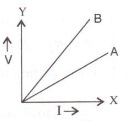
11.The V-I graph for a series combination and for a parallel combination of two resistors is shown in fig. Which of the two, A or B, represents the parallel combination? Give a reason for your answer.

Solution 11.
For the same change in I, change in V is less for the straight line A than for the straight line B (i.e., the straight line A is less steeper than B), so the straight line A represents small resistance, while the straight line B represents more resistance. In parallel combination, the resistance decreases while in series combination, the resistance increases. So A represents the parallel combination.
1(MCQ).In series combination of resistances:
P.d. is same across each resistance
Total resistance is reduced
Current is same in each resistance
All of the above are true
Solution 1 (MCQ).
In series combination of resistances, current is same in each resistance.
Hint: In a series combination, the current has a single path for its flow. Hence, the same current passes through each resistor.
2(MCQ).In parallel combination of resistances:
P.D. is same across each resistance
Total resistance is increased
Current is same in each resistance
All of the above are true
Solution 2 (MCQ).
In parallel combination of resistances, P.D. is same across each resistance.
Hint: In parallel combination, the ends of each resistor are connected to the ends of the same source of potential. Thus, the potential difference across each resistance is same and is equal to the potential difference across the terminals of the source (or battery).
3(MCQ).Which of the following combinations have the same equivalent resistance between X and Y?
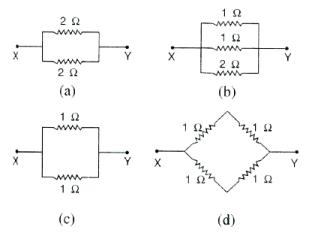
3(MCQ).Which of the following combinations have the same equivalent resistance between X and Y?

Solution 3 (MCQ).
Numericals
1.
Solution 1.
Solution 2.
Solution 3.
4.A battery of emf 15 V and internal resistance 3 ohm is connected to two resistors of resistances 3 ohm and 6 ohm in series. Find :
(a) the current through the battery
(b) the p.d. between the terminals of the battery.
Solution 4.
5.A cell of emf  and internal resistance r sends current 1.0 A when it is connected to an external resistance 1.9 ohm. But its sends current 0.5 A when it is connected to an external resistance of 3.9 ohm. Calculate the values of e and r.
and internal resistance r sends current 1.0 A when it is connected to an external resistance 1.9 ohm. But its sends current 0.5 A when it is connected to an external resistance of 3.9 ohm. Calculate the values of e and r.
Solution 5.
6.Two resistors having resistance 4  and 6
and 6  are connected in parallel. Find their equivalent resistance.
are connected in parallel. Find their equivalent resistance.
Solution 6.
7.Four resistors each of resistance 2 ohm are connected in parallel. What is the effective resistance?
Solution 7.
8.You have three resistors of values 2 , 3
, 3 and 5
and 5 . How will you join them so that the total resistance is less than 1
. How will you join them so that the total resistance is less than 1 ? Draw diagram and find the total resistance.
? Draw diagram and find the total resistance.
Solution 8.
9.Three resistors each of 2 W are connected together so that their total resistance is 3 W. Draw a diagram to show this arrangement and check it by calculation.
Solution 9.
Solution 10.
11.A combination consists of three resistors in series. Four similar sets are connected in parallel. If the resistance of each resistor is 2 ohm, find the resistance of the combination.
Solution 11.
12.In the circuit shown below in figure, calculate the value of x if the equivalent resistance between A and B is 4 W.

Solution 12.
Solution 13.
14.A wire of uniform thickness with a resistance of 27 ohm is cut into three equal pieces and they are joined in parallel. Find the resistance of the parallel combination.
Solution 14.
15.A circuit consists of a 1 ohm resistor in series with a parallel arrangement of 6 ohm and 3 ohm resistors. Calculate the total resistance of the circuit. Draw a diagram.
Solution 15.
Solution 16.
17.Calculate the equivalent resistance between the points A and B in the adjacent diagram in the figure.
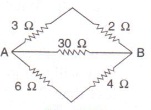
Solution 17.
18.In the network shown in adjacent figure, calculate the equivalent resistance between the points (a) A and B (b) A and C
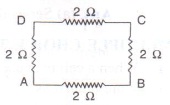
Solution 18.
19.Five resistors, each 3 ohm, are connected as shown in figure . Calculate the resitance (a) between pionts P and Q (b) between points X and Y.
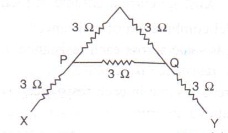
Solution 19.
20.Two resistors of 2 ohm and 3 ohm are connected (a) in series, (b) in parallel, with a battery of 6.0 V and negligible internal resistance. For each case draw a circuit diagram and calculate the current through battery.
Solution 20.
21.A resistor of 6 ohm is connected in series with another resistor of 4 ohm. A potential difference of 20 V is applied across the combination. (a) Calculate the current in the circuit and (b) potential difference across the 6 ohm resistor.
Solution 21.
Solution 22.
23.In figure, calculate :
(a) the total resistance of the circuit.
(b) the value of R, and
(c) the current flowing in R
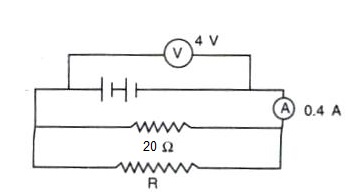
Solution 23.
24.A particular resistance wire has a resistance of 3 ohm per meter. Find :
(a) The total resistance of three lengths of this wire each 1.5 m long, in parallel.
(b) The potential difference of the battery which gives a current of 2 A in each of the 1.5 m length when connected in the parallel to the battery (assume that resistance of the battery is negligible).
(c) The resistance of 5 m length of a wire of the same material, but with twice the area of cross section.
Solution 24.
25.A cell supplies a current of 1.2 A through two 2 ohm resistors connected in parallel. When resistors are connected in series, it supplies a current of 0.4 A. Calculate: (i) the internal resistance and (ii) e.m.f. of the cell.
Solution 25.
26.A battery of emf 15 V and internal resistance 3 ohm is connected to two resistors 3 ohm and 6 ohm connected in parallel. Find (a) the current through the battery (b) p.d. between the terminals of the battery (c) the current in 3 ohm resistor (d) the current in 6 ohm resistor.
Solution 26.
27.The following circuit diagram shows three resistors 2  , 4
, 4  and R
and R connected to a battery of e.m.f. 2 V and internal resistance 3
connected to a battery of e.m.f. 2 V and internal resistance 3  . A main current of 0.25 A flows through the circuit.
. A main current of 0.25 A flows through the circuit.
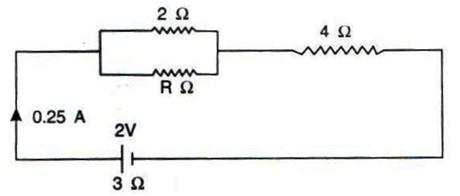
(a) What is the p.d. across the 4 ohm resistor?
(b) Calculate the p.d. across the internal resistance of the cell.
(c) What is the p.d. across the R  or 2
or 2  resistor?
resistor?
(d) Calculate the value of R.
Solution 27.
28.Three resistors of 6.0 ohm, 2.0 ohm and 4.0 ohm are joined to ammeter A and a cell of emf 6.0 V as shown in figure. Calculate :
(a) the efective resistance of the circuit.
(b) the reading of ammeter
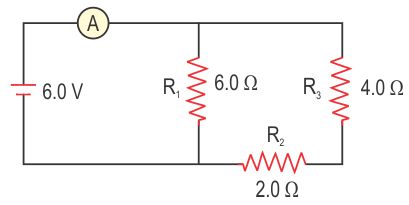
Solution 28.
29.The diagram below in Fig., shows the arrangement of five different resistances connected to a battery of e.m.f. 1.8 V. Calculate :
a. The total resistance of the circuit
b. The reading of ammeter A.
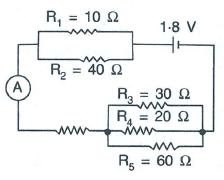
Solution 29.
Exercise 8(C)
1.Write an expression for the electrical energy spent in flow of current through an electrical appliance in terms of current, resistance and time.
Solution 1.
Solution 2.
3.Electrical power P is given by the expression
(a)What do the symbols Q and V represent?
(b)Express the power P in terms of current and resistance explaining the meanings of symbols used there in.
Solution 3.
Solution 4.
The S.I. unit of electrical energy is joule.
1Wh = 3600 J
5.Explain the meaning of the statement 'the power of an appliance is 100 W'.
5.Explain the meaning of the statement 'the power of an appliance is 100 W'.
Solution 5.
The power of an appliance is 100 W. It means that 100 J of electrical energy is consumed by the appliance in 1 second.
6.State the S.I. units of electrical power.
Solution 6.
The S.I. unit of electrical power is Watt.
7.(i)State and define the household unit of electricity.
(ii)What is the voltage of the electricity that is generally supplied to a house?
Solution 7.
(i) The household unit of electricity is kilowatt-hour (kWh).
One kilowatt-hour (kWh) is the electrical energy consumed by an electrical appliance of power 1 kW when it is used for one hour.
(ii) The voltage of the electricity that is generally supplied to a house is 220 Volt.
8.Name the physical quantity which is measured in (i) kW, (ii) kWh.
Solution 8.
(i) Electrical power is measured in kW and
(ii) Electrical energy is measured in kWh.
9.Define the term kilowatt - hour and state its value in S.I. unit.
Solution 9.
One kilowatt-hour (kWh) is the electrical energy consumed by an electrical appliance of power 1 kW when it is used for one hour.
Its value in SI unit is 1kWh = 3.6 x 106J
10.Distinguish between kilowatt and kilowatt-hour.
Solution 10.
Kilowatt is the unit of electrical power whereas kilowatt-hour is the unit of electrical energy.
11.Complete the following:
(a)
(b)
1 kWh= ________ J
Solution 11.
12.What do you mean by power rating of an electrical appliance? How do you use it to calculate (a) the resistance of the appliance and (b) the safe limit of the current in it, while in use?
Solution 12.
An electrical appliance such as electric bulb, geyser etc. is rated with power (P) and voltage (V) which is known as its power rating. For example: If an electric bulb is rated as 50W-220V, it means that when the bulb is lighted on a 220 V supply, it consumes 50 W electrical power.
Solution 13.
It means that if the bulb is lighted on a 250 V supply, it consumes 100 W electrical power (which means 100J of electrical energy is converted in the filament of bulb into the light and heat energy in 1 second).
14.List the names of three electrical gadgets used in your house. Write their power, voltage rating and approximate time for which each one is used in a day. Hence find the electrical energy consumed by each in day.
14.List the names of three electrical gadgets used in your house. Write their power, voltage rating and approximate time for which each one is used in a day. Hence find the electrical energy consumed by each in day.
Solution 14.
15.Twolamps, one rated 220 V, 50 W and the other rated 220 V, 100 W, are connected in series with mains of 220 V. Explain why does the 50 W lamp consume more power.
Solution 15.
16.Name the factors on which the heat produced in a wire depends when current is passed in it, and state how does it depend on the factors stated by you.
Solution 16.
When current is passed in a wire, the heat produced in it depends on the three factors:
- on the amount of current passing through the wire,
- on the resistance of wire and
- on the time for which current is passed in the wire.
- Dependence of heat produced on the current in wire: The amount of heat H produced in the wire is directly proportional to the square of current I passing through the wire, i.e., H ∝ I2
- Dependence of heat produced on the resistance of wire: The amount of heat H produced in the wire is directly proportional to the resistance R of the wire, i.e., H ∝ R
- Dependence of heat produced on the time: The amount of heat H produced in the wire is directly proportional to the time t for which current is passed in the wire, i.e., H ∝ t
1(MCQ).When a current I flows through a resistance R for time t, the electrical energy spent is given by :
IRt
I2Rt
IR2t
I2R/t
Solution 1 (MCQ).
2(MCQ).An electrical appliance has a rating 100 W, 120V. The resistance of element of appliance when in use:
1.2 
144 
120 
100 
Solution 2 (MCQ).
Numericals
1.A current of 2 A is passed through a coil of resistance 75 Ω for 2 minutes. (a) How much heat energy is produced? (b) How much charge is passed through the resistance?
Solution 1.
2.Calculate the current through a 60 W lamp rated 250 V. If the line voltage falls to 200 V, how is power consumed by the bulb affected?
Solution 2.
3.An electric bulb is rated '100 W, 250 V'. How much current will the bulb draw if connected to a 250 V supply?
Solution 3.
4.An electric bulb is rated at 220 V, 100 W. (a) What is its resistance? (b) What safe current can be passed through it?
Solution 4.
Solution 5.
6.An electric iron is rated 750 W, 230 V. Calculate the electrical energy consumed by the iron in 16 hours.
Solution 6.
7.An electrical appliance having a resistance of is operated at 220 V. calculate the energy consumed by the appliance in 5 minutes. (i) in joules (ii) in kWh.
is operated at 220 V. calculate the energy consumed by the appliance in 5 minutes. (i) in joules (ii) in kWh.
Solution 7.
8.A bulb marked 12 V, 24 W operates on a 12 V battery for 20 minutes. Calculate:
(i)The current flowing through it, and
(ii)The energy consumed.
Solution 8.
9.A current of 0.2 A flows through a wire whose ends are at a potential difference of 15 V. Calculate:
(i)The resistance of the wire, and
(ii)The heat energy produced in 1 minute.
Solution 9.
10.What is the resistance, under normal working conditions, of an electric lamp rated at '240 v', 60 W? If two such lamps are connected in series across a 240 V mains supply, explain why each one appears less bright.
Solution 10.
When one lamp is connected across the mains, it draws 0.25 A current, while if two lamps are connected in series across the mains, current through each bulb becomes
(i.e., current is halved), hence heating (= I2Rt) in each bulb becomes one-fourth, so each bulb appears less bright.
11.Two bulbs are rated 60 W, 220 V and 60 W, 110 V respectively. Calculate the ratio of their resistances.
Solution 11.
12.An electric bulb is rated 250 W, 230 V.
(i) the energy consumed in one hour, and
(ii) the time in which the bulb will consume 1.0 kWh energy when connected to 230 V mains?
Solution 12.
13.Three heaters each rated 250 W, 100 V are connected in parallel to a 100 V supply. Calculate:
(i)The total current taken from the supply,
(ii)The resistance of each heater, and
(iii)The energy supplied in kWh to the three heaters in 5 hours.
Solution 13.
14.A bulb is connected to a battery of p.d. 4 V and internal resistance . A steady current of 0.5 A flows through the circuit. Calculate:
. A steady current of 0.5 A flows through the circuit. Calculate:
(i)The total energy supplied by the battery in 10 minutes,
(ii)The resistance of the bulb, and
(iii)The energy dissipated in the bulb in 10 minutes.
Solution 14.
15.Two resistors A and B of and
and  respectively are connected in parallel. The combination is connected across a 6 volt battery of negligible resistance. Calculate: (i) the power supplied by the battery, (ii) the power dissipated in each resistor.
respectively are connected in parallel. The combination is connected across a 6 volt battery of negligible resistance. Calculate: (i) the power supplied by the battery, (ii) the power dissipated in each resistor.
Solution 15.
16.A battery of e.m.f. 15 V and internal resistance is connected to two resistors of 4 ohm and 6 ohm joined (a) in series. Find in each case the electrical energy spent per minute in
is connected to two resistors of 4 ohm and 6 ohm joined (a) in series. Find in each case the electrical energy spent per minute in resistor.
resistor.
Solution 16.
17.Water in an electric kettle connected to a 220 V supply took 5 minutes to reach its boiling point. How long would it have taken if the supply had been of 200 V?
Solution 17.
18.An electric toaster draws 8 A current in a 220 V circuit. It is used for 2 h. Find the cost of operating the toaster if the cost of electrical energy is Rs. 4.50 per kWh.
Solution 18.
19.An electric kettle is rated 2.5 kW, 250 V. Find the cost of running the kettle for two hours at Rs. 5.40 per unit.
Solution 19.
20.A geyser is rated 1500 W, 250 V. This geyser is connected to 250 V mains. Calculate:
(i)The current drawn,
(ii)The energy consumed in 50 hours, and
(iii)The cost of energy consumed at Rs 4.20 per kWh.
Solution 20.
- Get link
- X
- Other Apps
Labels
Class 10 ICSE Physics
Labels:
Class 10
ICSE Physics
- Get link
- X
- Other Apps






























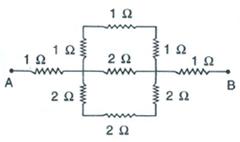









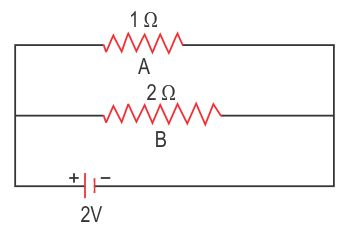






































Comments
Post a Comment
This site is all about helping you kids study smart because for Gen Z, studying "hard" is not enough. If you feel there is any way I could improve my posts or if you have any random suggestion that might help make this more kid friendly, please don't hesitate to drop in a comment!
Be sure to check back for my response if you've asked me a question or requested a clarification through the comment section because I do make every effort to reply to your comments here.